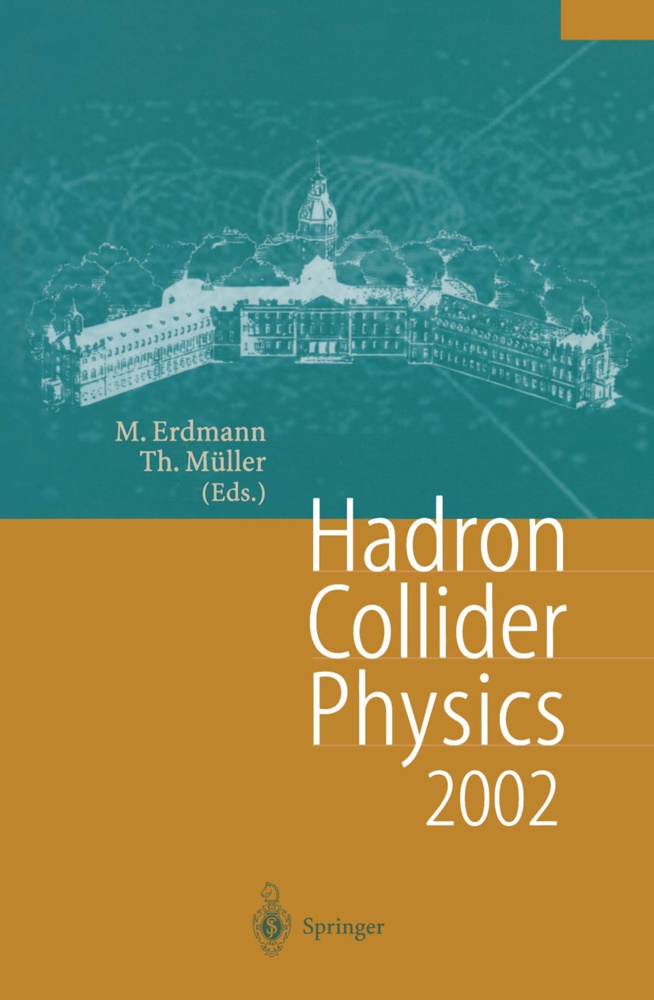Mehr lesen
Hadron colliders probe physics at new energy frontiers and search for new particles and forces. In addition, hadron colliders now provide also an environment for precision physics. The present volume collects the results from recently completed runs at major colliders as well as new ideas about collider physics and techniques. It will serve as the main source of reference in the field for many years to come.
Inhaltsverzeichnis
I Opening Review on Hadron-Collider Physics.- Hadron Colliders, the Standard Model, and Beyond.- II Status of the Accelerators and Detectors.- Tevatron Collider Run II Status.- Status of CDF II and Prospects for Run II.- Status of the DØ Detector.- III Standard Model Processes: Parton Luminosities, QCD Evolution.- The Proton Structure as Measured at HERA.- Global Fits of Parton Distributions.- Low x Physics at HERA.- Saturation Effects in Hadronic Cross Sections.- IV Standard Model Processes: QCD at High pt.- Progress in NNLO Calculations for Scattering Processes.- Heavy Flavour Production at DØ.- Heavy Quark Production at CDF.- Heavy Quark Production at HERA.- Theoretical Developments on Hard QCD Processes at Colliders.- Jet Production at CDF.- Jet Algorithms at DØ.- Jet Physics at HERA.- Global Photon Summary.- Hadron Production in Hadron-Hadron and Lepton-Hadron Collisions.- V Standard Model Processes: QCD: Diffractive Processes.- Measurements of Diffractive Processes at HERA Aharon Levy.- Diffractive Physics at DØ.- Measurements of Diffractive Processes at CDF.- Selected topics in Rapidity Gap Physics.- VI Standard Model Processes: Heavy-Ion Collisions.- Recent Results from STAR.- VII Standard Model Processes: Heavy Flavour, CKM and CP-Violation.- Beauty and Charm Physics at CDF, First Results and Perspectives.- Prospects for B Lifetimes, Oscillations and CP Violation at DØ.- Impact of Bottom-Quark Measurements on our Knowledge of the Standard Model.- VIII Standard Model Processes: W, Z-Bosons, Electroweak Parameters.- Electroweak Physics Prospects for CDF in Run II.- Measurement of the Z and W Boson Production Cross.- Associated Hadroproduction of Charmonia and Electroweak Bosons.- Review of Potential for Precision Electroweak Studies at the LHC.- IXStandard Model Processes: Top Quark.- Top Quark Physics at DØ.- Top Quark Physics with CDF.- The Top Quark: Experimental Roots and Branches of Theory.- X Searches for New Phenomena: Higgs.- Higgs Production at Hadron Colliders.- Higgs Searches and Prospects at CDF.- Prospects for Higgs Bosons at DØ.- Prospects of Higgs Physics at the LHC.- XI Searches for New Phenomena: Alternative Symmetry Breaking Mechanisms, SUSY, Extra.- Dimensions, Anomalous Couplings, Leptoquarks and Compositness Isolated Lepton Signatures at HERA.- Searches for New Particles/Phenomena at CDF.- Searches and Expected Signatures at DØ.- Searches and Discovery Prospects at HERA.- Supersymmetry at the LHC: Searches, Discovery Windows, and Expected Signatures.- Searches, Discovery Windows, and Expected Signatures of New Phenomena at ATLAS and CMS.- XII Tools and Techniques for Physics Analysis: Luminosity Determination in Hadron-Hadron Collisions, Event Generators, New Developments in Analysis Techniques.- Luminosity Determination at the Tevatron.- Luminosity Measurement at the LHC.- Precision Parton Luminosities at the LHC.- Event Generators - New Developments.- HERA Event Generators for the Low Mass Region.- Optimal Use of Information for Measuring Mt in Lepton+jets tt¯ Events.- Multivariate Analysis Techniques for Final State Reconstruction.- Jet Algorithms: a Mini-Review.- CDF ? Triggers, Analysis and Other Developments.- User Oriented Design in High Energy Physics Applications: Physics Analysis Expert.- XIII Future Colliders.- Why We Need Both the LHC and an e+e¯ Linear Collider.- XIV Summary Talk.- Summary and Highlights of the Conference.
Über den Autor / die Autorin
Martin Erdmann ist Professor für Experimentalphysik am Physikalischen Institut der RWTH Aachen.
Thomas Müller, Verleger seit 1987, Gründer und Vorstand der TM BöRSENVERLAG AG, Gründer und Geschäftsführer der boerse.de Finanzportal GmbH. Thomas Müller verfasste in den 90er-Jahren zahlreiche Artikel, Reports und Bücher zu den Schwerpunkt-Themen Derivate und technische Analysen.
Zusammenfassung
Hadron colliders probe physics at new energy frontiers and search for new particles and forces. In addition, hadron colliders now provide also an environment for precision physics. The present volume collects the results from recently completed runs at major colliders as well as new ideas about collider physics and techniques. It will serve as the main source of reference in the field for many years to come.

